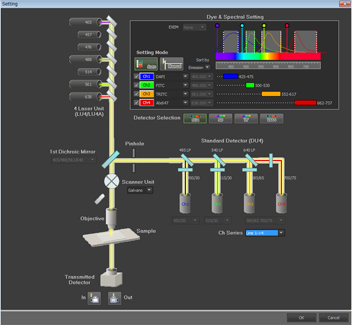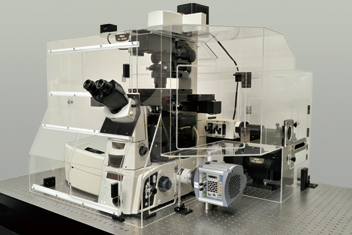
Confocal microscope A1R+ configured with Ti-E
Capturing high-quality confocal images at ultrahigh-speed and enhanced sensitivity with a resonant scanner and galvano scanner, A1R+ is a powerful tool for the acquisition of intracellular dynamics and interaction.
Hybrid scanner for ultrafast photoactivation imaging
A1R+ has a hybrid scanner head that incorporates both an ultrahigh-speed resonant scanner and a high-resolution galvano scanner. Simultaneous photoactivation and ultrafast imaging using these two scanners allow acquisition of rapid changes after photoactivation and enables observation of intermolecular interaction.

HeLa cells expressing Yellow Cameleon 3.60 were excited with 457 nm laser light. After stimulation with histamine, calcium ion concentration dynamics were observed. The (blue) emission of CFP and the (yellow) emission of YFP are shown as green and red channels respectively. The graph displays fluorescence intensity (vertical) versus time (horizontal). The green and red lines in the graph indicate the intensity change of CFP emission (green) and YFP emission (red) from the region of interest (ROI). Along with the increase of calcium ion concentration in the cell, the intermolecular FRET efficiency between CFP and YFP within Yellow Cameleon 3.60 increases, the CFP fluorescence intensity decreases, and the YFP fluorescence intensity increases.
Imaging laser wavelength: 457 nm, Image size: 512 x 512 pixels, 30 fps (with resonant scanner)
Photos courtesy of: Dr. Kenta Saito and Prof. Takeharu Nagai, Research Institute for Electronic Science, Hokkaido University
What is a hybrid scanning head?
This mechanism allows flexible switching or simultaneous use of two scanners (resonant and galvano) with the use of a hyper selector.

Ultrafast imaging with a resonant scanner

A1'R+s resonant scanner has an ultrahigh resonance frequency of 7.8 kHz. It allows imaging of intercellular dynamics at 30 fps (512 x 512 pixels) and 420 fps (512 x 32 pixels), the world's fastest image acquisition. The field of view of the scanned area is approximately five times larger than that of the galvano scanner. The Nikon original optical clock generation method realizes high image quality even at the highest speed. The fiber-optic communication data transfer system can transfer data at a maximum of 4Gbps.

Mouse blood vessel administered Tetramethyl Rhodamine and Acridine Orange and observed at 120 fps (8 ms/frame, with resonant scanner)
Red: blood vessel, Green: nucleus
Tile images displayed every 8 ms
The arrows indicate white blood cell flow in the vessel.
Photos courtesy of: Dr. Satoshi Nishimura, Department of Cardiovascular Medicine, the University of Tokyo, Nano-Bioengineering Education Program, the University of Tokyo, PRESTO, Japan Science and Technology Agency
High-resolution imaging with a galvano scanner
The A1R+'s galvano scanner enables high-resolution imaging of up to 4096 x 4096 pixels. In addition, with the newly developed scanner driving and sampling systems, plus image correction technology, high-speed acquisition of 10 fps (512 x 512 pixels) is also possible.


Image of a zebrafish labeled with four probes (captured with galvano scanner)
Nucleus (blue): Hoechst33342, Pupil (green): GFP, Nerve (yellow): Alexa555, Muscle (red): Alexa647
Photographed with the cooperation of: Dr. Kazuki Horikawa and Prof. Takeharu Nagai, Research Institute for Electronic Science, Hokkaido University
Increased light detection efficiency realizes high image quality
The low-angle incidence method utilized on the dichroic mirrors increases fluorescence efficiency by 30%.

By employing the hexagonal pinhole, higher brightness equivalent to that of a circular pinhole is achieved.

Nikon's original dual integration signal processing technology (DISP) has been implemented in the image processing circuitry to improve electrical efficiency, resulting in an extremely high S/N ratio.
VAAS pinhole unit for bright, clear images
Nikon has developed an original confocal microscopy VAAS (Virtual Adaptable Aperture System, option) that can eliminate flare while retaining image brightness. Because of the deconvolution of the light that passes through the pinhole and the light that does not pass through the pinhole, acquisition of brighter images with less flare is possible. Different sectionings (slice thicknesses) can also be simulated after image acquisition.

Photographed with the cooperation of: Dr. Yasushi Okada, Laboratory for Cell Polarity Regulation, Quantitative Biology Center, RIKEN
Enhanced spectral imaging
High-speed spectral imaging
Acquisition of a 32-channel spectral image (512 x 512 pixels) with a single scan in 0.6 second is possible. Moreover, 512 x 32-pixel images can be captured at 24 fps.
Accurate and high-speed unmixing

Accurate spectral unmixing provides maximum performance in the separation of closely overlapping fluorescence spectra and the elimination of autofluorescence. Superior algorithms and high-speed data processing enable real time unmixing during image acquisition.

Actin of HeLa cell expressing H2B-YFP was stained with Phalloidin-Alexa488.
Spectral image in the 500-692 nm range captured with 488 nm laser excitation
Left: Spectral image, Right: Unmixed image (green: Alexa488, red: YFP)
Specimen courtesy of: Dr. Yoshihiro Yoneda and Dr. Takuya Saiwaki, Faculty of Medicine, Osaka University
Simultaneous excitation of four lasers
Three user-defined laser shields allow simultaneous use of four lasers selected from a maximum of nine colors, enabling broader band spectral imaging.
V-filtering function
Filter-less intensity adjustment is possible by selecting desired spectral ranges from 32 channels that match the spectrum of the fluorescence probe in use and combining them to perform the filtering function.

Simple operation of complex applications
NIS—Elements C control software enables integrated control of the confocal imaging system, microscope and peripheral devices with a simple and intuitive interface. Diverse reliable analysis functions are also available.

Basic operation

Optical setting

Configuration of A1+ with N-SIM
System integration of Ti-E inverted microscope for multi-mode imaging is possible by equipping the confocal microscope system with N-SIM/N-STORM super resolution microscope system, TIRF system, spectral detector and Perfect Focus System. All systems can be controlled by a single NIS-Elements platform.

